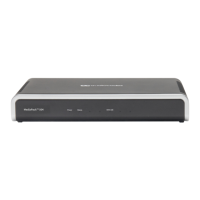SIP User's Manual 268 Document #: LTRT-65415
MediaPack Series
b. The device initiates the release procedures for the B-channel associated
with the call request and maps the preemption cause to PRI Cause = #8
‘Preemption’. This value indicates that the call is being preempted. For PRI,
it also indicates that the B-channel is not reserved for reuse.
c. The device sends a SIP 200 OK in response to the received BYE, before the
SIP end instrument can proceed with the higher precedence call.
• The softswitch performs a network preemption of an outbound call request for the
device that has not received a SIP 2xx response - the following sequence of
events occur:
a. The softswitch sends the device a SIP 488 (Not Acceptable Here) response
code with this Reason cause code. The device initiates the release
procedures for the B-channel associated with the call request and maps the
preemption cause to PRI Cause = #8 ‘Preemption’.
b. The device deactivates any user signaling (e.g., ringback tone) and when
the call is terminated, it sends a SIP ACK message to the softswitch
For a complete list of the MLPP parameters, see ''MLPP Parameters'' on page 454.
8.2.8 SIP Call Routing Examples
8.2.8.1 SIP Call Flow Example
The SIP call flow (shown in the following figure), describes SIP messages exchanged
between two devices during a basic call. In this call flow example, device (10.8.201.158)
with phone number ‘6000’ dials device (10.8.201.161) with phone number ‘2000’.
Figure 8-17: SIP Call Flow

